Morphology of Trace Fossils
An accurate classification of the trace fossils should provide a description
of the morphology, the relationship of the trace producer with the sediment,
and the interpretation of the mechanism of trace creation.
For an easier identification of commonly encountered trace fossil groups
we will use the ethological classification.
Resting traces (cubichnia)
The main features of the resting traces are:
-
they follow the bedding planes and are preserved in semirelief
-
their shape reflects the body outline of the producer
-
their features are well defined, imitating the lower part of the producer
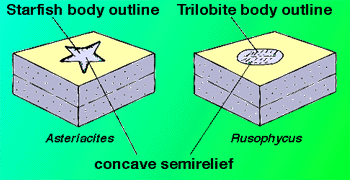 |
|
Resting traces (after Doyle, 1996)
|
Typical resting traces are belong to genera Rusophycus (commonly
associated with trilobites), and Asteriacites (associated with starfish).
Some resting traces grade sometimes into locomotion traces (e.g.. Rusophycus
into Cruziana)
Locomotion traces (repichnia)
Locomotion traces may be recognized by the following criteria:
-
they follow the bedding planes and are preserved in semirelief
-
the motion of the producer was directional or random, rather than systematic
-
they are usually associated with impressions or prod marks left by the
producer
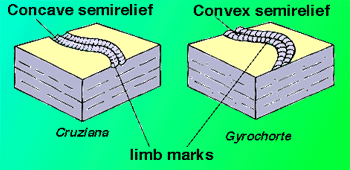 |
|
Resting traces (after Doyle, 1996)
|
Typical terrestrial locomotion traces are footprints. Typical marine ichnogenus
is Cruziana, a simple burrow having a simple linear path and paired
plough marks left by limbs and appendages. It is preserved as a positive
relief on the base of a sedimentary layer (convex hyporelief), in opposition
with Gyrochorte, a similar trace, produced at a very shallow depth,
preserved in positive relief on the upper surface of a sedimentary layer
(convex epirelief). The structure of the trace is produced by the sediments
which pass over the upper surface of the animal.
Dwelling traces (domichnia)
Dwelling traces may be recognized by the following criteria:
-
they may be horizontal or vertical, preserved in full relief
-
they are usually cylindrical tubes (straight or U-shaped) or more complex
branching systems
-
they may bear evidence of scratches or prod marks (left by appendages),
cemented or lined walls
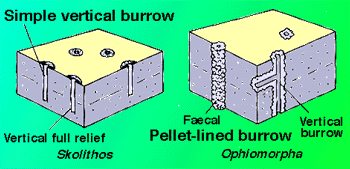 |
|
Dwelling traces (after Doyle, 1996)
|
Typical dwelling traces include: Skolithos (a simple, unpaired pipe),
Ophiomorpha (lined with faecal pellets - which determine a nodular
outer surface to the burrow - usually associated with crustaceans), Teredolites
(bivalve borings cut into driftwood), and Gastrochaenolites (bivalve
borings cut into firm or rock substrates).
Grazing traces (pascichnia)
The common characteristics of the grazing traces are:
-
they are preserved in semirelief on the bedding plane surface
-
they are meandering and systematic, usually with a regular system of switchbacks,
regularly spaced
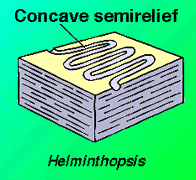 |
|
Grazing trace Helminthopsis (after Doyle,
1996)
|
Typical grazing traces include: Nereites and Spiroraphe (regular,
spirally induced grazing patterns on the sediment surface), Helminthopsis
(complex series of grazing switchbacks), and Paleodictyon (network
of regular polygons resulted from systematic feeding).
Feeding burrows (fodinichnia)
Feeding burrows can be grouped on the basis of the feeding process into:
-
penetrative into sediment and preserved in full relief
-
formed by progressive or systematic mining of the sediment
-
spreites - more complex burrows characterized by back-filling features
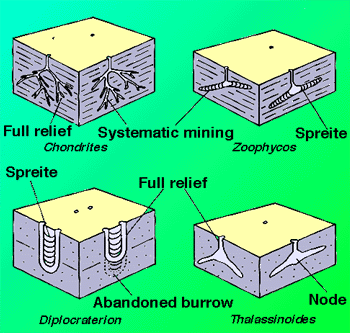 |
|
Feeding burrows (after Doyle, 1996)
|
Feeding burrows include: Chondrites (downward branching burrow),
Zoophycos (complex downward spiralling burrow), Diplocraterion
(feeding / dwelling vertical, U-shaped burrow), Rhizocorallium (
feeding / dwelling vertical, then horizontal, U-shaped burrow), and Thalassinoides
(feeding / dwelling trace, displaying a network of 'triple junction' interconnected
vertical and horizontal tubes, usually associated with shrimps).
|




